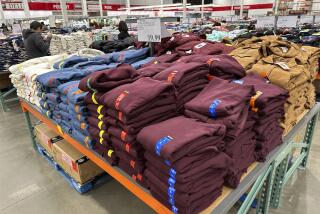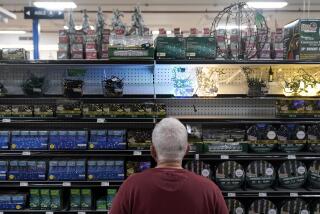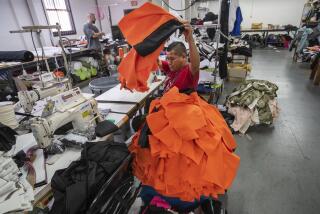Durable Goods Orders Decline 3% in January
- Share via
WASHINGTON — Orders to factories for “big ticket” durable goods dropped 3% in January, the government said Thursday in a report that some analysts said could portend a welcome slowdown in economic growth.
The Commerce Department said total orders fell $4 billion to a seasonally adjusted $128.06 billion last month, pulled down by sharp declines in the volatile transportation and defense sectors.
Virtually all other major industrial categories were down as well.
With other reports indicating that the strong economy has resulted in an acceleration of inflation, analysts said some moderation in the pace of growth would be constructive.
“This is one of the first signs that the economy is cooling off,” Maury Harris, chief economist for Paine Webber Inc. in New York , said of January’s decline in orders. “If you continue to get this weakness in February and March, then all these inflation worries . . . will fall by the wayside.”
Last month’s decrease in orders was concentrated in reduced demand for ships and tanks, which affect both the transportation and military categories. Orders for aircraft and parts remained strong, although down from December’s high levels.
‘Definite Deceleration’
Overall, transportation orders fell back 7.2% last month after a 22.1% surge in December. Excluding transportation, orders in all other categories were down 1.2% in January.
In the erratic defense category, subject to wide swings depending on when government contracts are signed, orders plunged 33.5% in January after a 24.2% increase in December. Excluding defense, all other orders were down 0.4% last month.
January’s 3% decrease in total orders was the biggest decline since a 7.4% drop last July and the first drop since a 2.8% decrease in September.
Robert Dederick, chief economist for Northern Trust Co. in Chicago, said manufacturers were experiencing “a definite deceleration in the rate of advance” after an earlier boom that was fueled by strong demand for exports and capital equipment.
Orders had been up 10.9% for all of 1988, the best showing since 1984, and had risen a robust 7.3% in December.
“The sizzling, blistering, frenetic pace that we had earlier has given way to something that is more temperate,” Dederick said. “That is perhaps desirable given the concern about inflation. It suggests we are perhaps moving toward a more sustainable growth path.”
However, Jerry Jasinowski, chief economist for the National Assn. of Manufacturers, said it was too early to be seeing signs of significant slowing.
More to Read
Inside the business of entertainment
The Wide Shot brings you news, analysis and insights on everything from streaming wars to production — and what it all means for the future.
You may occasionally receive promotional content from the Los Angeles Times.










